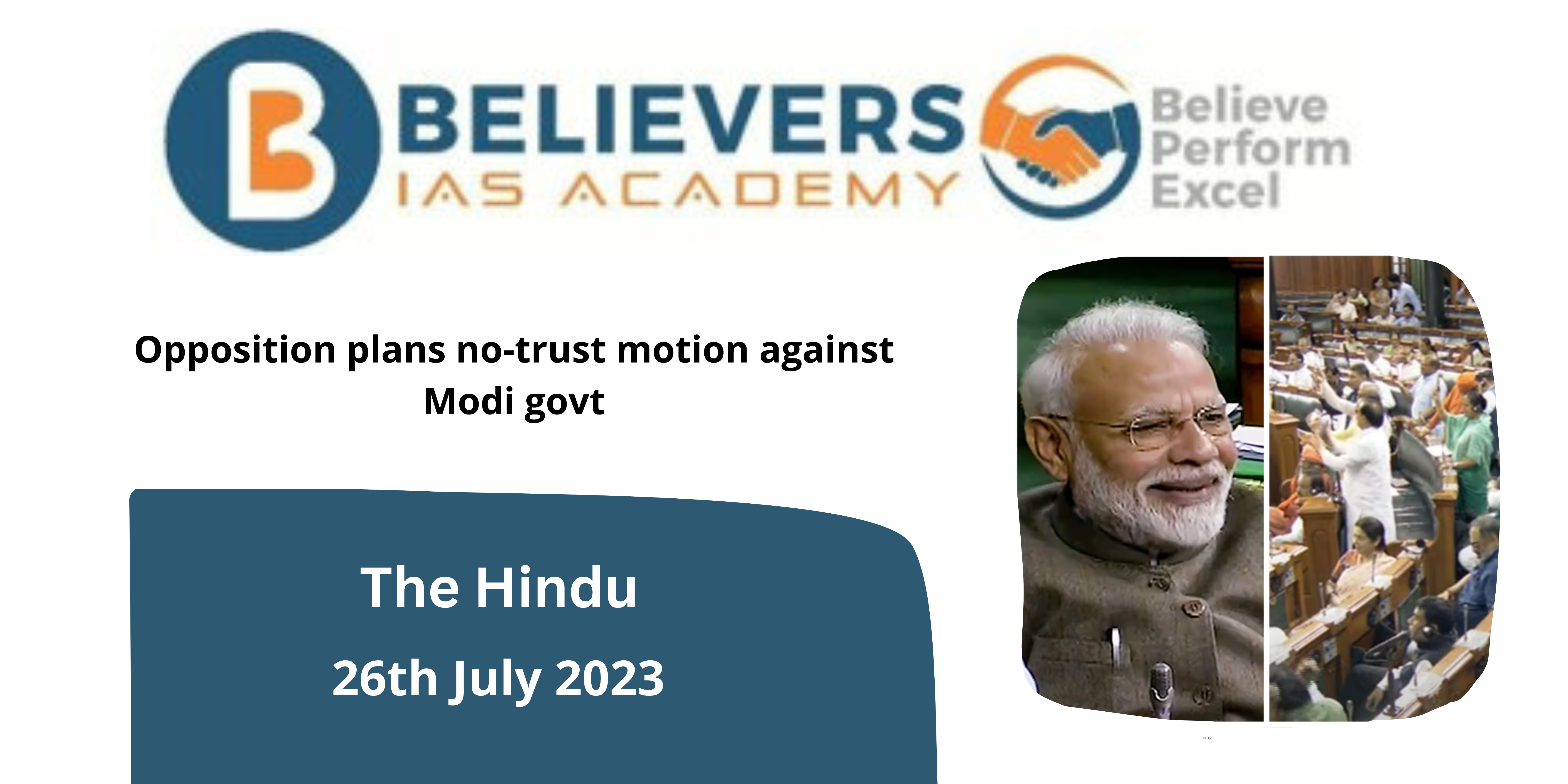Opposition plans no-trust motion against Modi govt
Context
To push the Narendra Modi administration to address the agitation in Manipur, opposition parties affiliated with INDIA plan to introduce a no-confidence motion against it in the Lok Sabha on Wednesday.
What is No Confidence Motion?
- Definition: The No Confidence Motion is a legislative measure that the opposition has introduced in the Lok Sabha, the lower house of the Indian Parliament. It says that because of flaws or failure to uphold its obligations, the council of ministers (the government) is unsuitable to function in their leadership capacities.
- Purpose: The No Confidence Motion’s primary goal is to put the majority of the current government to the test. If the motion is approved, it will mean that the government no longer has the support of the majority of Lok Sabha members.
- Majority: The No Confidence Motion must receive the backing of at least 51% of the Lok Sabha’s members to pass.
- Government Resignation: If the No Confidence Motion is approved, the government must resign because it no longer has the majority support required to govern successfully.
- The No Confidence Motion method is outlined in Rule 198 of the Lok Sabha Rules of Method and Conduct. Procedural Rules:
- The No Confidence Motion can only be introduced by the opposition, and
- it needs the support of at least 50 members to pass.
- Formal Notice: By 10 AM on the proposed day, the members wishing to move the motion must provide formal notice to the Secretary-General of the Lok Sabha. If this is not practicable, it must be turned in by 10 AM the following day.
- Speaker’s Decision: After reading the motion and confirming that it is in order, the Lok Sabha’s Speaker may ask the members who support it to take their seats up.
- Discussion: Within ten days of the leave request, the motion is brought up for discussion if the Speaker grants the motion. The discussion may take place over a few days or at a certain time designated by the Speaker.
- Voting: The Speaker brings the motion to a vote on the designated day, and it is deemed successful if at least 51% of the members back it.
- Speech Time Limit: The speaker has the authority to set a speech time limit throughout the discussion.
What is the significance of No-Confidence Motion?
The No Confidence Motion is significant for the following reasons:
a. It offers a way to hold the government responsible for its policies and actions.
b. It gives the opposition a chance to criticize the government’s performance and demand a leadership change.
c. It guarantees that the administration must consistently demonstrate that it has the support of the majority to stay in office, upholding democratic checks and balances.
d. It gives the opposition a platform from which to raise important concerns and call for government action.
What is the difference between Confidence Motion vs. No Confidence Motion?
- A confidence motion is one that the administration introduces to gauge the strength of its support and to ask the Lok Sabha to endorse its plans and choices.
- No Confidence Motion: A resolution introduced by the opposition to put the majority of the current administration to the test and express disapproval of its leadership.
- Real-world Example: The No Confidence Motion filed by the YSR Congress and Telugu Desam Party against the NDA Government following the termination of their coalition with the BJP exemplifies how the motion may be used to address significant issues and gauge the strength of the government.
Why was the No Confidence motion recently in the news?
- The Indian National Developmental, Inclusive Alliance (INDIA)-affiliated opposition parties want to introduce a no-confidence motion against the Narendra Modi administration in the Lok Sabha.
- To make the Prime Minister address the ongoing unrest in Manipur, this motion was introduced.
- The INDIA bloc’s Congress party is eager to introduce the no-confidence motion on Wednesday morning.
- To guarantee that each of its Lok Sabha members attends a parliamentary party meeting, the Congress has imposed a three-line whip.
- Before introducing the motion, the floor leaders of the 26 parties that make up the INDIA group will confer to ensure that it has at least 50 votes to pass the House.
- Further tensions have been caused by the Prime Minister’s comparison of the opposition parties to the British East India Company.
- The government is willing to have a conversation about Manipur, and the home minister has written to the opposition leaders to ask for their cooperation.
- The Prime Minister, meanwhile, has been charged with “grave parliamentary impropriety” by certain Congress leaders for speaking about Manipur outside the House but avoiding debate on the subject in Parliament.





